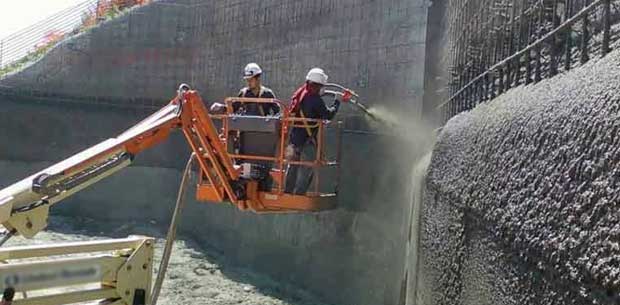
The gunite is a mixture of cement and sand, in the proportion of 1:3. It is the term given for “dry shotcrete process”. Guniting is the most effective process of repairing concrete work that has been damaged due to inferior work or other reasons and is used for providing an impervious layer. Gunite is sprayed pneumatically onto the surfaces at a high velocity surface under a pressure of about 20 to 30 N/cm2. Once the gunite is applied it starts a simultaneous process of consolidation and settling.
Shotcrete Types: Dry Shotcrete and Wet Shotcrete
Application of shotcrete may be dry or wet. In the dry application of shotcrete the ingredients are placed in a hopper and are pushed out pneumatically through a hose to the nozzle. The addition of water at the nozzle is controlled which mixes up once the material hits the surface. Using dry shotcrete or guniting allows the benefit of adjusting the water content that is going to be put into the mix instantaneously. This enables better placement process without the addition of accelerators. Dry application is preferred when the process involves frequent stops during the process of application.
In wet-mix shotcrete, prepared concrete or the ready mixed concrete is used. Use of compressed air is done at the nozzle that propels the wet mixture over the receiving surface. Less rebound and less dust as compared to dry application of shotcrete has made the wet-mix application as the most common process. The greatest advantage of the wet-mix process is that larger volumes can be placed in less time.
Advantages of Guniting
- Placing and consolidation occurs simultaneously.
- Shotcrete will adhere to surfaces better than that of regular concrete.
- Shotcrete can also be used with steel fibers that will be used as a replacement of welded wire mesh. This enables better flexural strength, ductility and toughness.
- It offers lower costs compared to traditional concrete.
- It offers reduced shrinkage and lower permeability.
Application of gunite
Gunites are used in slope stabilization, tunneling, retention walls, water tanks and pools, artificial ponds, ditches and channels. They are also used as structural reinforcement and mining applications.
